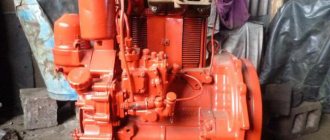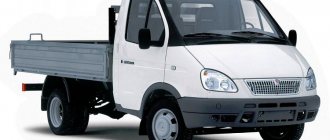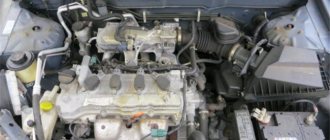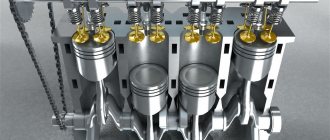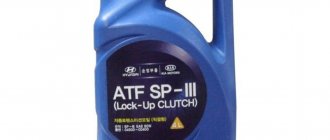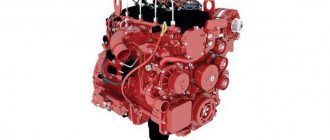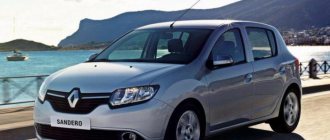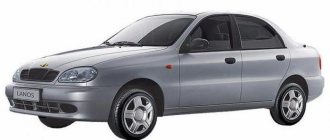The ZMZ 406 engine was being developed to replace the 402 engine simultaneously with the design of the GAZ-3105 car for the government. However, these new Volgas were equipped with them only for the last batch, which had to be urgently sold due to the removal of the cars from production.
ICE ZMZ 406
The basis was taken from the ZMZ 402 (equipment) and the H series engine from the manufacturer SAAB (design solutions). As a result, with the same volume of 2.3 liters, the power drive provided 177 Nm of torque instead of the prototype’s 210 Nm and 100 hp. With. power instead of the expected 150 hp, like the Swedish internal combustion engine. The injection system, which later replaced the carburetor, was able to improve the situation slightly - 201 Nm and 145 hp. s., respectively.
Carburetor version ZMZ 4061.10
Technical characteristics of ZMZ 406 2.3 l/100 l. With.
For the first time, several advanced technical solutions for that time were used in the engine of the manufacturer ZMZ:
- two intake and two exhaust valves per cylinder;
- electronic ignition and injection systems;
- diagram of the DOCH gas distribution mechanism with two overhead camshafts;
- hydraulic pushers instead of adjusting the thermal clearance of valves with gaskets.
Valve tappets
After the changes made, the technical characteristics of ZMZ 406 correspond to the values given in the table:
| Manufacturer | ZMZ |
| Engine brand | 406 |
| Years of production | 1997 – 2008 |
| Volume | 2286 cm3 (2.3 l) |
| Power | 73.55 kW (100 hp) |
| Torque moment | 177/201 Nm (at 4200 rpm) |
| Weight | 192 kg |
| Compression ratio | 9,3 |
| Nutrition | injector/carburetor |
| Motor type | in-line petrol |
| Ignition | switchboard |
| Number of cylinders | 4 |
| Location of the first cylinder | TVE |
| Number of valves on each cylinder | 4 |
| Cylinder head material | aluminum alloy |
| Intake manifold | duralumin |
| An exhaust manifold | cast iron |
| Camshaft | 2 pcs. DOCH scheme |
| Cylinder block material | cast iron |
| Cylinder diameter | 92 mm |
| Pistons | original |
| Crankshaft | lightweight |
| Piston stroke | 86 mm |
| Fuel | AI-92/A-76 |
| Environmental standards | Euro-3/Euro-0 |
| Fuel consumption | highway – 8.3 l/100 km combined cycle 11.5 l/100 km city – 13.5 l/100 km |
| Oil consumption | maximum 0.3 l/1000 km |
| What kind of oil to pour into the engine by viscosity | 5W30, 5W40, 10W30, 10W40 |
| Which engine oil is best by manufacturer | Liqui Moly, LukOil, Rosneft |
| Oil for ZMZ 406 by composition | synthetic in winter, semi-synthetic in summer |
| Engine oil volume | 6.1 l |
| Operating temperature | 90° |
| ICE resource | declared 150,000 km actual 200,000 km |
| Adjustment of valves | hydraulic pushers |
| Cooling system | forced, antifreeze |
| Coolant volume | 10 l |
| water pump | with plastic impeller |
| Spark plugs for ZMZ 406 | domestic A14DVRM or A14DVR |
| Spark plug gap | 1.1 mm |
| Valve train chain | 70/90 with shoe or 72/92 with sprockets |
| Cylinder operating order | 1-3-4-2 |
| Air filter | Nitto, Knecht, Fram, WIX, Hengst |
| Oil filter | with check valve |
| Flywheel | 7 offset holes, 40mm inner diameter |
| Flywheel mounting bolts | M12x1.25 mm, length 26 mm |
| Valve stem seals | Goetze, light intake, dark exhaust |
| Compression | from 13 bar, difference in adjacent cylinders maximum 1 bar |
| XX speed | 750 – 800 min-1 |
| Tightening force of threaded connections | spark plug – 31 – 38 Nm flywheel – 72 – 80 Nm clutch bolt – 19 – 30 Nm bearing cap – 98 – 108 Nm (main) and 67 – 74 (rod) cylinder head – three stages 40 Nm, 127 – 142 Nm + 90° |
The factory manual contains a more precise description of the parameters:
- ZMZ 4063.10 – carburetor, compression ratio 8 for operation on A-76 fuel, power 110 hp. s., torque 186 Nm, weight 185 kg;
- ZMZ 4061.10 – carburetor, compression ratio 8 for A-76 gasoline, power 100 hp. s., torque 177 Nm, weight 185 kg;
- ZMZ 4062.10 – injector, compression ratio 9.3 for AI-92 fuel, power 145 hp. s., torque 201 Nm, weight 187 kg.
ZMZ 4063.10
ZMZ 4062.10 injector
Changing the oil in the Gazelle 406 engine
Initially, the ZMZ-406 engine, produced by the Zavolzhsky Motor Plant, was designed for installation in luxury cars with modern microprocessor-controlled fuel supply systems. Later, starting in 1997, they began to equip Gorky cars GAZ 3102, 3110 and GAZelle with it. At the same time, the engine underwent “modernization” for carburetor fuel supply systems, which led to the appearance of such units as ZMZ-4061.10 and ZMZ-4063.10.
The following shows an oil change for a GAZelle (GAZ-3302) in a ZMZ-4062.10 injection engine.
When to change and how much oil to pour into the ZMZ 406 engine
It is the responsibility of each driver to monitor the technical condition of all vehicle systems. It is recommended to check the oil level in your car every 300-500 km, depending on the technical condition of the engine, before leaving the car on a route. And every 10,000 km, it is necessary to change the oil while simultaneously replacing the filter element. It is also necessary to check the lubrication system for leaks (no oil leaks or oil stains).
According to the operating manual, the ZMZ 406 engine requires 6 liters of oil . However, when filling it, it is recommended not to pour all the lubricant at once. It is necessary to maintain the lubricant level at about o, since the crank heads of the connecting rods will be immersed in the lubricant and splash it, thereby causing the formation of oil mist in the crankcase. This negatively affects the operation of the engine as a whole.
What oil to pour into a GAZelle with a 406 engine
The oil for the ZMZ 406 engine must comply with the classification STO AAI 003-98 (API): B4/D2 (SJ/CF); B4/D2 (SG/CD); SJ/SH/CF. And also correspond in viscosity to the values of maximum and minimum annual temperatures:
- from -25 to +20 °C 5W-30;
- from -25 to +35 °C 5W-40;
- from -20 to +30 °C 10W-40;
- from -20 to +35 °C 15W-30;
- from -15 to +35 °C 15W-40;
- from -15 to +45 °C 15W-40;
- from -10 to +45 °C 20W-40;
- from -5 to +45 °С SAE 30.
The manufacturer offers the following brands of oil, both domestic and foreign, for use: “Slavneft Lux” 5W-30, 5W-40, 10W-30, 10W-40, 15W-40, 20W-50; "Slavneft Ultra" 5W-30, 5W-40, 10W-30, 10W-40, 15W-40, 20W-50; "Lukoil Super" 5W-30, 10W-40, 15W-40; "Esso Ultra" 10W-40, "Esso Uniflo" 15W-40.
First, let's look at the manufacturer's recommendations. Oils with viscosity 10-40, 5-40, 0-40. Probably everyone knows that the first number indirectly indicates the “pumpability” of the product at low temperatures. Pay attention to the second number. It's the same everywhere. The viscosity of 5-30 is not indicated anywhere. I'll try to explain why in a nutshell.
ZMZ engines are very poorly bored. The so-called “group method”. That is, 100 blocks were brought from the boring machine, the pistons are guaranteed to fit into them and the engine should start working. This phenomenon has a pederastic name in our factories - “assembly guarantee”. The gap in the piston-cylinder pair should be on average 6 acres (0.06mm). Four hundred square meters is a clear gap and two or three hundred square meters per hole in the cylinder. The average figure for ZMZ engines is 10 acres. There were specimens up to 15 acres. What am I talking about? Oddly enough about the viscosity of the oil.
Thinner oils for a given engine can be simply destructive. With such gaps, it simply will not stay in the piston-cylinder pair. Therefore, the factory recommends oils of these viscosities. The plant simply provided itself with insurance.
SAE
The viscosity classification depends on the region of operation of the engine. The factory formula belongs to the 5W30 class. The following varieties can be used as analogues:
- 5W40;
- 10W30;
- 10W40;
- 15W40;
- 20W40.
This is interesting: What to do and how to open the lock in the car if the driver's door is jammed
API/GOST
The model is characterized by the use of API category oils
- SJ/CF;
- SG/CD;
- SJ/SH/CF.
According to the requirements of STO AAI 003-98, category B4/D2 is applicable.
Important! The vehicle passport contains information about the minimum specifications of lubricants. It is strictly forbidden to fill in formulas that do not meet the manufacturer’s requirements. Such manipulations can cause power plant failure, loss of warranty, and unexpected breakdowns. Operation of trains exceeding the tolerances is permitted.
Also, some experts recommend saving the remainder of the portion for subsequent refilling of liquid during use.
How often to change the lubricant
The frequency of engine oil changes on the Gazelle 406 is determined based on operating conditions.
The standard recommendation provided by the manufacturer is 10 thousand kilometers. Under normal conditions, car owners should adhere to this interval between services for replacing motor lubricant.
Normal operating conditions are considered:
- highways from 1 to 3 categories;
- flat road or slightly hilly areas;
- asphalt covering.
Here we are talking about completely urban conditions and the highway.
But since the Gazelle is a commercial vehicle, it is not always possible to drive it exclusively on asphalt and flat roads
For drivers who operate the car in more difficult conditions, special adjustments are made. The worse the road surface, the shorter the interval between fluid changes in the Gazelle engine oil sump becomes.
- When driving the Gazelle 406 on gravel and crushed stone roads, visiting suburban areas, it is recommended to change the engine oil every 9 thousand kilometers.
- In small settlements where gravel, hilly and cobblestone roads predominate, the oil change interval is reduced to 8 thousand kilometers.
- It is recommended to change the engine fluid every 7 thousand kilometers if the main operating conditions for the Gazelle 406 are large cities with crushed stone, gravel and bitumen-mineral surfaces, and the terrain is mountainous or with a large number of hilly areas.
- On-farm roads, internal quarry roads, rural areas and natural soil wear out the engine more, and the oil loses its characteristics more rapidly. Therefore, when traveling on such roads, you should change the oil at intervals of at least every 6 thousand kilometers.
Nobody forbids you to perform the lubricant replacement procedure earlier. But exceeding the established standards by more than 500 kilometers is strongly not recommended.
At this point, the oil in the Gazelle 406 engine is at the limit of its capabilities, and its physical and chemical properties are practically lost. Increasing the set threshold leads to rapid wear of parts, the formation of a large amount of contaminants, with a subsequent risk of failure of the power unit.
Design Features
Officially, the ZMZ 406 engine became the third after 24D and 402 in the line of power drives of the Zavolzhsky plant. Received microprocessor ignition, DOCH gas distribution circuit with a two-stage chain drive.
The developers still used an in-line engine design with 4 cylinders, but there were two camshafts, they are located on top, inside the cylinder head. The compression ratio of the internal combustion engine was increased by the plant designers to 9.3 in the basic version 4062.10 due to the central location of the spark plug inside the combustion chamber.
Gas distribution mechanism design
Reliability is increased due to a cast-iron cylinder block without liners, a reduction in the piston stroke to 86 mm and the weight of the entire ShPG group. The connecting rods, bolts, crankshaft and piston rings are made from high-strength materials, so major overhauls are required less frequently.
Timing chain tensioner
The chain tensioners are automatic, double-acting - preloaded by a spring during hydraulic operation. The degree of oil purification is increased by installing a full-flow disposable filter. A separate V-belt drive is provided for attachments. The ECU firmware corresponds to SOATE, ITELMA VS5.6, MIKAS 5.4 or 7.1 versions
Car engines of the ZMZ-406 family
ZMZ-406 family
are gasoline automobile internal combustion engines produced by JSC Zavolzhsky Motor Plant.
Prototypes have been assembled since 1992, in serial production since 1997. Fuel injection was used for the first time. This family of engines was widely used on Gorky Automobiles 3102, 31029, 3110 and GAZelle. The flagship of the family is the ZMZ-4062.10, a 2.28-liter 16-valve engine capable of developing power up to 150 hp.
The ZMZ-4062.10 engine is designed for installation in middle-class passenger cars and minibuses.
The ZMZ-4061.10, ZMZ-4063.10 engines are designed for installation on light-duty Gazelle-type trucks and minibuses.
| Parameter name | ZMZ-4062 | ZMZ-4061 | ZMZ-4063 | ZMZ-4052 | ZMZ-409 |
| Working volume, l | 2,3 | 2,46 | 2,69 | ||
| Cylinder diameter, mm | 92 | 95,5 | |||
| Piston stroke, mm | 86 | 94 | |||
| Compression ratio | 9,1 | 8,0 | 9,5 | 9,3 | 9,0 |
| Supply system | Injection | Carburetor | Injection | ||
| Rated power, kW (hp) | 110,3 (150) | 73,5 (100) | 80,9 (110) | 118,8 (152) | 105 (142,8) |
| Rotation speed at rated power, min-1 | 5200 | 4500 | 4500 | 5200 | 4400 |
| Max. torque, N*m (kgf*m) | 206 (21) | 181,5 (18,5) | 191,3 (19,5) | 210,0 (21,5) | 230 (23,5) |
| Rotation speed at rated power, min-1 | 5200 | 4500 | 4500 | 5200 | 4400 |
| Speed at max. torque, min-1 | 4000 | 3500 | 3500 | 4300 | 3900 |
| Idle speed, min-1 (min+-50 / max) | 800 / 6000 | 750 / 6000 | 850 / 6000 | 850 / 5000 | |
| Minimum specific fuel consumption, g/kW*h (g/hp*h) | 252 (185) | 273 (200) | 265 (195) | ||
| Cylinder operating order | 1-3-4-2 | ||||
| Oil consumption for waste, % of fuel consumption | 0,3 | 0,4 | 0,3 | ||
| Engine weight supplied by the factory, kg | 187 | 185 | 187 | 190 | |
Engines ZMZ-4061, ZMZ-4063
- carburetor, four-cylinder, in-line with a microprocessor ignition control system.
A general view of the engines is shown in Figures 1 and 3.
A cross section of the engines is shown in Figure 2.
- drain plug;
- oil sump;
- an exhaust manifold;
- engine support bracket;
- coolant drain valve;
- water pump;
- emergency coolant temperature sensor;
- coolant temperature indicator sensor;
- engine temperature sensor;
- thermostat housing;
- emergency oil pressure sensor;
- oil pressure indicator sensor;
- oil level indicator (dipstick);
- ignition coil
- oil sump;
- oil pump receiver;
- oil pump;
- oil pump drive;
- intermediate shaft gear;
- cylinder block;
- inlet pipe;
- ventilation pipes;
- intake camshaft;
- inlet valve;
- valve cover;
- exhaust camshaft;
- oil level indicator (dipstick);
- valve lifter;
- outer valve spring;
- valve guide;
- Exhaust valve;
- cylinder head;
- an exhaust manifold;
- piston;
- piston pin;
- connecting rod;
- crankshaft;
- connecting rod cover;
- main bearing cap;
- drain plug;
- pusher body;
- guide bushing;
- compensator body;
- retaining ring;
- compensator piston;
- ball valve;
- ball valve spring;
- ball valve body;
- expansion spring
- sync disk;
- timing sensor;
- oil filter;
- starter;
- knock sensor;
- coolant drain pipe from the heater;
- inlet pipe;
- hydraulic chain tensioner;
- generator;
- generator belt;
- water pump pulley;
- tension roller;
- gasoline pump
The main design features of the engines are the upper (in the cylinder head) location of two camshafts with the installation of four valves per cylinder (two inlet and two exhaust), increasing the compression ratio to 9.3 due to a combustion chamber with a central spark plug.
These technical solutions made it possible to increase maximum power and maximum torque, reduce fuel consumption and reduce exhaust gas emissions.
To increase reliability, the engine uses a cast iron cylinder block without insert liners, which has high rigidity and more stable gaps in the friction pairs, the piston stroke is reduced to 86 mm, the weight of the piston and piston pin is reduced, higher quality materials are used for the crankshaft, connecting rods, connecting rod bolts , piston pins, etc.
The camshaft drive is a chain, two-stage, with automatic hydraulic chain tensioners; the use of valve mechanism hydraulic pushers eliminates the need to adjust the gaps.
The use of hydraulic devices and engine boosting require high quality oil purification, so the engine uses a high-efficiency full-flow oil filter (“superfilter”) for single use. An additional filter element prevents unclean oil from entering the engine when starting a cold engine and clogging the main filter element.
The microprocessor ignition control system allows you to adjust the ignition timing, including the detonation parameter under changing engine operating conditions, which allows you to ensure the necessary indicators - power, economic and exhaust gas toxicity.
The auxiliary units (coolant pump and generator) are driven by a flat poly-V belt.
The engine is equipped with a diaphragm clutch with ellipsoid-wound driven disc linings, which have high durability.
Source
List of internal combustion engine modifications
Initially, the engine was designed to be fuel-injected, so version 4062.10 is considered the basic one. The need for carburetor modifications 4061.10 and 4063.10 arose later. They were installed on Gazelle, so while maintaining the volume of the combustion chambers, it was necessary to reduce the owner’s operating costs. To do this, ZMZ management lowered the compression ratio in order to switch the engines to cheaper A-76 fuel.
Versions of the ZMZ 406 engine differ in combustion chambers
A reverse modernization was made with motors 4061 and 4063:
- reduced power and torque;
- XX speed became 750 min-1 instead of 800 min-1;
- Maximum torque is achieved at 3500 rpm, rather than 4000.
Everything else mounted is located in the same places without changes. Some parts are interchangeable, with the exception of the cylinder head and piston.
Advantages and disadvantages
A negative feature of the ZMZ 406 power drive is the low quality of casting and poor technical solutions:
- high oil consumption due to unfinished ring design;
- low timing life of the drive due to the tensioner, collapsible block star and bulky design as a whole.
Fuel consumption is high, but this is typical for most truck engines.
But vibrations are reduced, the cylinder head does not unscrew during operation, the gasket does not need to be constantly changed, and the nuts do not need to be tightened. The maintainability of all components is high, the design itself is reliable and simple. The user is spared the need to adjust valve clearances every 20,000 miles.
Intake manifold injector
List of car models in which it was installed
Since the ZMZ 406 engine has three versions, each of them was used on specific models of the car manufacturer GAZ:
- ZMZ 4062.10 – GAZ 31054 Luxury configuration; GAZ 3102 (1996 – 2008);
- ZMZ 4061.10 – GAZ 3302, 33023, 2705, 3221;
- ZMZ 4063.10 – GAZ 3302, 33023, 2705, 3221, 32213, 322132, 32214, SemAR 3234, Ruta, Bogdan and Dolphin.
GAZ Gazelle Farmer
In the first case, the engine characteristics were suitable for the urban cycle of executive cars of officials and governments. Carburetor modifications reduced the operating budget of Gazelle vans, utility vehicles and trucks.
Maintenance schedule ZMZ 406 2.3 l/100 l. With.
According to the manufacturer's requirements, the ZMZ 406 engine is serviced in the following order:
- inspection of the timing chain after 30,000 miles, replacement after 100,000 km;
- oil and filter change after 10,000 km;
- replacing the coolant approximately every two years or 30,000 mileage;
- recharging the battery every autumn, replacing after 50,000 km;
- spark plugs last for 60,000 miles;
- the fuel filter becomes unusable after 30,000 km, the air filter - 20,000 km;
- Ignition coils fail after 50,000 miles.
Repair of ZMZ 406
The manufacturer recommends using high-quality lubricant for engines so that the hydraulic compensators and oil pump work properly. Initially, the cooling system has weak points - the radiator and thermostat. All attachments are highly durable, with the exception of the pump, the polymer rotor of which lasts about 30,000 km. Due to the heavy weight of the engine, it is very difficult to carry out major repairs yourself in a garage without a hoist.
Review of faults and methods for repairing them
Due to its design features, the ZMZ 406 motor bends the valve only when the chain jumps. Moreover, they are damaged by each other (intake and exhaust during simultaneous lifting), and not by the pistons. If the chain breaks, such a problem will not happen.
Since the internal combustion engine device is partially copied from the SAAB, and the design of the ZMZ 402 is partially preserved, it is characterized by malfunctions:
| High speed XX | 1) sensor failure 2) there is no contact of the XX regulator 3) crankcase ventilation hoses are torn | 1)replacement of sensors 2)restoring contact 3)replacement of hoses |
| Cylinder failure | 1) ECU malfunction 2) coil failure 3) breakdown of the spark plug tip 4) nozzle failure | 1)replacement of the control unit 2) coil repair 3)replacement of tip 4) repair/replacement of nozzle |
| Unstable operation of the internal combustion engine | 1) air leaks 2) water in the fuel tank | 1) restoring tightness, replacing gaskets 2) draining gasoline, drying the tank |
| The engine does not start | 1) failure of the ignition system 2) interruption of the fuel supply | 1)replacement of coil, contact 2)replacement of filter, pressure reducing valve, phase adjustment, replacement of fuel pump |
Due to the large diameter of the pistons, the block and cylinder head are sensitive to overheating, so the level of working fluids (oil and antifreeze) should be checked regularly.
Common faults and operation
- Most often, owners complain about capricious carburetor versions;
- The timing chain has low reliability (it does not bend if the valve breaks);
- The ignition system causes many problems, most often the coils;
- Hydraulic compensators usually last no more than 50,000 km, and then start knocking;
- The oil scraper rings quickly become stuck and the oil burn begins.
The carburetor 406 engine is less economical due to the impossibility of accurately adjusting the gasoline supply. It is almost impossible to more accurately regulate the amount of fuel, which affects power and fuel consumption.
The injector is noticeably superior to its carburetor counterpart in terms of reliability, efficiency and power. One of the main positive qualities of injectors is the absence of the need to make mandatory engine adjustments. The power supply system here is not subject to clogging, there are no jets, and the exact amount of fuel flows directly into the cylinders.
Engines models ZMZ-4061.10 and 4063.10 (left view): 1 - drain plug; 2 - oil sump; 3 — exhaust manifold; 4 — engine support bracket; 5 — coolant drain valve; 6 - water pump; 7 — emergency coolant temperature sensor; 8 — coolant temperature indicator sensor; 9 — engine temperature sensor; 10 — thermostat housing; 11 — emergency oil pressure sensor; 12 — oil pressure indicator sensor; 13 — oil level indicator (dipstick); 14 - ignition coil.
Engines model ZMZ-4061.10 and 4063.10 (right view): 1 - synchronization disk; 2 — synchronization sensor; 3 - oil filter; 4 - starter; 5 — knock sensor; 6 — pipe for draining coolant from the heater; 7 — inlet pipe; 8 — hydraulic chain tensioner; 9 - generator; 10 — generator belt; 11 — water pump pulley; 12 — tension roller; 13 - fuel pump.
Cross section of ZMZ-4061.10 and 4063.10: 1 - oil sump; 2 — oil pump receiver; 3 - oil pump; 4 — oil pump drive; 5 — intermediate shaft gear; 6 — cylinder block; 7 — inlet pipe; 8 — ventilation pipes; 9 — intake camshaft; 10 — inlet valve; 11 — valve cover; 12 — exhaust camshaft; 13 — oil level indicator (dipstick); 14 — hydraulic valve pusher; 15 — outer valve spring; 16 — valve guide; 17 — exhaust valve; 18 — cylinder head; 19 — exhaust manifold; 20 - piston; 21 — piston pin; 22 — connecting rod; 23 - crankshaft; 24 — connecting rod cover; 25 — main bearing cover; 26 — drain plug; 27 — pusher body; 28 — guide sleeve; 29 — compensator body; 30 — retaining ring; 31 — compensator piston; 32 - ball valve; 33 — ball valve spring; 34 — ball valve body; 35 — expansion spring.
This is interesting: What to do and what the fine is if the license plate light does not light up
List of models where the internal combustion engine was used: GAZ 3102 Volga, GAZ 31029 Volga, GAZ 3110 Volga, GAZ 31105 Volga, GAZ Gazelle, GAZ Sobol (Already rated times: 5 ) Loading…
Engine tuning options
Initially, the ZMZ 406 engine allows you to increase the power on your own to 200 - 250 hp. With. Mechanical tuning is used for this:
- installation of a zero resistance filter;
- reduction of air temperature in the intake tract;
- replacement of the standard K-16D carburetor with Solex (adjustment with quality/quantity screws is required).
Tuning ZMZ 406
For Gazelle minibuses and trucks, turbo tuning is ineffective, since the service life of the diesel engine is reduced and fuel consumption increases sharply.
Thus, the injection modification ZMZ 4062.10 and carburetor versions 4061.10, 4063.10 are developed on the basis of the Swedish H series engine for trucks and executive cars. Tuning is allowed, primarily to increase torque.
If you have any questions, leave them in the comments below the article. We or our visitors will be happy to answer them
Detailed diagram of the ZMZ 406 engine
We can say with great confidence that the LION'S share of cargo transportation today falls on the vehicles of the Gorky Automobile Plant. The 406 Gazelle engine has three modifications - two carburetor and one injection. Moreover, the injection engine is installed on both minibuses and passenger cars.
The advantages of the 406 Gazelle engine include its efficiency, with high power. Whatever they say, the engine’s reliability is high only with proper maintenance and operation. But it also has its drawbacks. The engine is very picky about the quality of engine oil and spark plugs. Plus - the engine cooling system is imperfect, overheating occurs, since the fan on the radiator often refuses to work.
There are pros and cons everywhere, but in general, the 406 engine is a reliable unit that has earned the trust of many motorists. In addition, the stores have a wide selection of spare parts for these engines. In the event of a breakdown of a component or a major overhaul of the engine, you will not spend very much money. Compared to servicing foreign-made engines.
Engine characteristics.
All three modifications (ZMZ-4061.10, ZMZ-4062.10 and ZMZ-4063.10) have a working volume of 2.3 liters. Only the first engine is carburetor, designed for 76 gasoline, the second is injection, for 92 gasoline, and the third is carburetor, also for 92 gasoline. The cylinder diameter and piston stroke in all three modifications are the same - 92 and 86 millimeters, respectively. Engines have different power, depending on the modification. For example, the Gazelle engine 4061.10 has a power of one hundred horsepower, 4062.10 - 145 horsepower, and 4063.10 - one hundred and ten.
The use of an injection system made it possible to increase not only power, but also increase torque. If on a Gazelle carburetor engine running on 76-octane gasoline the torque is 176 Nm, then on the injection version it is already equal to 200 Nm. Accordingly, the use of a more powerful engine improves the dynamic characteristics of the vehicle both with and without a load. This gives the loaded Gazelle confidence even when climbing climbs.
The 406 engine is, one might say, the first motor that operates under electronic control. For the first time, electronics from the German company Bosch were used in the engine, and in large quantities. Also, the Gazelles have a dual-circuit ignition system with two coils. Electronic control units - domestic production (MIKAS, SOATE).
Engine structure ZMZ-406
1 – drain plug; 2 – oil sump; 3 – exhaust manifold; 4 – engine support bracket; 5 – coolant drain valve; 6 – water pump; 7 – coolant overheating lamp sensor; 8 – coolant temperature indicator sensor; 9 – temperature sensor; 10 – thermostat; 11 – sensor for emergency oil pressure lamp; 12 – oil pressure indicator sensor; 13 – crankcase ventilation hose; 14 – oil level indicator (dipstick); 15 – ignition coil; 16 – phase sensor; 17 – heat-insulating screen.
The cylinder block is cast from gray cast iron. There are channels for coolant between the cylinders. The cylinders are made without insert liners. At the bottom of the block there are five crankshaft main bearing supports. The main bearing caps are made of ductile iron and are secured to the block with two bolts. The bearing caps are bored together with the block, so they cannot be swapped.
All covers, except the cover of the third bearing, have their serial numbers stamped on them. The third bearing cover together with the block is machined at the ends to install thrust bearing half washers. The chain cover and oil seal holder with crankshaft seals are bolted to the ends of the block. The oil sump is attached to the bottom of the block. On top of the block is a cylinder head cast from aluminum alloy. It contains intake and exhaust valves. Each cylinder has four valves, two intake and two exhaust. The intake valves are located on the right side of the head, and the exhaust valves are located on the left.
The valves are driven by two camshafts through hydraulic tappets. The use of hydraulic tappets eliminates the need to adjust the gaps in the valve drive, since they automatically compensate for the gap between the camshaft cams and valve stems. On the outside of the hydraulic pusher body there is a groove and a hole for supplying oil into the hydraulic pusher from the oil line.
Engine type mod. 4062 on the right side.
1 – synchronization disk; 2 – speed and synchronization sensor; 3 – oil filter; 4 – starter; 5 – knock sensor; 6 – coolant drain pipe; 7 – air temperature sensor; 8 – inlet pipe; 9 – receiver; 10 – ignition coil; 11 – idle speed regulator; 12 – throttle; 13 – hydraulic chain tensioner; 14 – generator.
